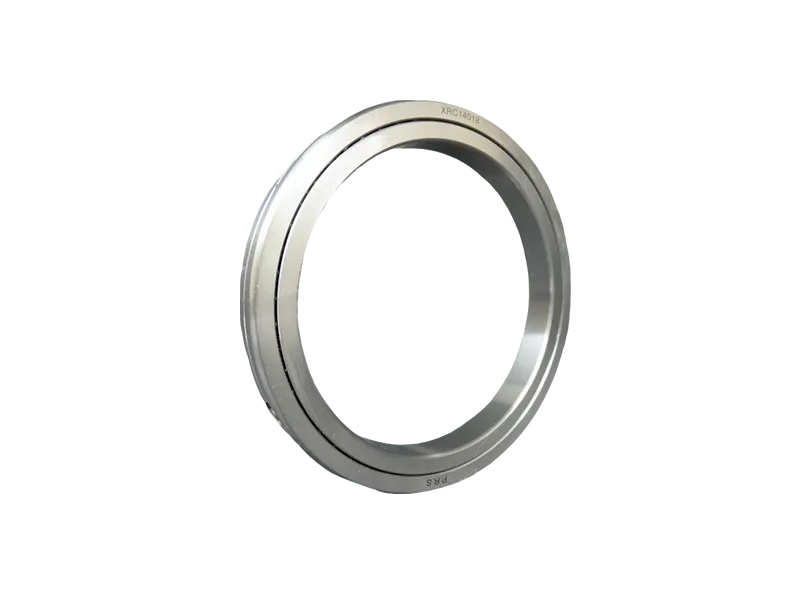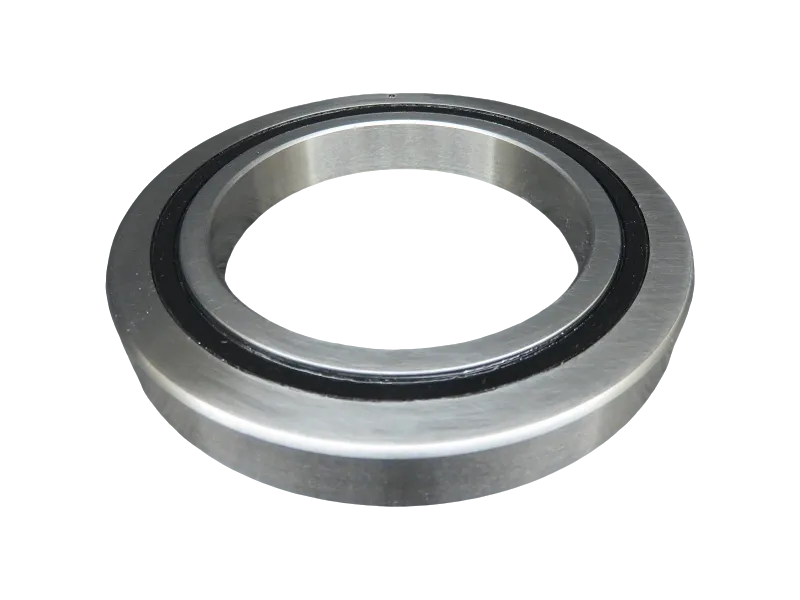2025-08-13 02:41:34PRS Bearings
Replacing crossed roller bearings is a precise and often delicate procedure, as these bearings are commonly used in applications requiring high levels of precision, such as machine tools and robotics. Proper handling and installation are essential to ensure the replacement is successful and does not compromise the performance of the equipment.

Step 1: Gather Tools and Materials
Safety Gear: Safety glasses, gloves.
The New Bearing: Keep it in its sealed packaging until the moment of installation.
Manufacturer's Manual: This is your most important tool. It contains specific torque values, tightening sequences, and lubricant types.
Tools:
A calibrated torque wrench.
Hex keys or socket set.
Lint-free wipes and a suitable solvent (e.g., isopropyl alcohol).
Soft mallet (rubber or plastic).
Prying tools (use with extreme caution).
Dial indicator with a magnetic base.
Feeler gauges and a straightedge.
Lubricant: The specific grease or oil recommended by the bearing or machine manufacturer.
Step 2: Safety First - Lockout/Tagout
De-energize the machine completely. Follow all lockout/tagout (LOTO) procedures to ensure it cannot be started accidentally.
Step 3: Clean the Work Area
Thoroughly clean the exterior of the machine around the bearing housing. This prevents dirt and debris from falling into the housing during disassembly.
Step 4: Disassemble Surrounding Components
Carefully remove any covers, motors, gears, or other parts that obstruct access to the bearing. Take photos or label parts and fasteners to simplify reassembly.
Step 5: Loosen and Remove Mounting Bolts
Loosen the mounting bolts gradually and in a crisscross or star pattern. Do not remove one bolt completely while others are still tight. This prevents warping the housing or the bearing itself.
Once all bolts are loose, remove them.
Step 6: Remove the Old Bearing
Crossed roller bearings are often a light press-fit or a clearance fit.
If the housing has jacking screw holes, use them to push the bearing out evenly.
If not, you may need to gently and evenly pry the bearing out. Never strike the bearing directly with a steel hammer. If tapping is required, use a block of wood or a soft mallet and tap around the circumference to "walk" it out evenly.
Support the bearing as it comes free to prevent it from dropping.
This is the most critical phase for ensuring the new bearing's longevity.
Step 1: Inspect the Old Bearing
Look at the old bearing for signs of failure. Is there brinelling (dents in the raceway), corrosion, uneven wear, or heat discoloration? This can provide clues about underlying problems (e.g., misalignment, overload, contamination) that need to be fixed before installing the new one.
Step 2: Thoroughly Clean Mounting Surfaces
Use a solvent and lint-free cloths to clean every surface where the new bearing will sit—the housing bore and face, and the shaft shoulder and diameter.
Remove all old lubricant, debris, rust, and fretting corrosion.
Step 3: Inspect Mounting Surfaces for Damage
Check for Burrs and Nicks: Run a finger (carefully) or a soft stone over the surfaces. Any raised metal will create a high spot, preventing the bearing from seating flat. Remove burrs with a fine file or deburring stone, being careful not to remove excess material.
Check for Flatness: Use a straightedge and feeler gauges to inspect the flatness of the housing and shaft shoulders. Any deviation can cause uneven loading on the bearing.
Check Dimensions: If possible, measure the housing bore and shaft diameter to ensure they are within the manufacturer's specified tolerances.
Step 1: Unpack the New Bearing
Only remove the new bearing from its protective packaging immediately before installation. This minimizes exposure to dust and contaminants. Do not wash the factory-applied anti-corrosion coating unless the manufacturer's manual specifically instructs you to.
Step 2: Confirm Orientation
Many crossed roller bearings have mounting holes, lubrication holes, or match marks. Double-check the orientation against your photos or the machine diagram to ensure it is correctly positioned.
Step 3: Position the Bearing
Apply a very thin film of light oil or the specified grease to the housing and shaft surfaces. This aids in smooth installation and prevents corrosion.
Carefully align the bearing with the housing. Slide it into place by hand, pushing it evenly. It should slide on smoothly. If it binds, stop, remove it, and re-inspect for misalignment or burrs. Never force it.
Step 4: The Critical Tightening Procedure
This procedure establishes the correct preload. Rushing this step will ruin the bearing.
Install Bolts: Lightly oil the threads of the new or cleaned mounting bolts. Insert them and tighten them by hand until they are just snug. The bearing should still be able to shift slightly.
Settle the Bearing: Gently tap the outer and inner rings with a soft mallet in a circular pattern to ensure the bearing is perfectly seated against the housing and shaft shoulders.
Torque in Stages and Sequence:
First Stage (e.g., 30% Torque): Using a calibrated torque wrench, tighten the bolts in a star pattern to about 30% of the final specified torque value.
Second Stage (e.g., 60% Torque): Repeat the star pattern, tightening the bolts to 60% of the final torque.
Final Stage (100% Torque): Repeat the star pattern a final time, tightening each bolt to its full specified torque.
Final Pass: Go around the bolts one last time in a circular pattern to verify that all are at the correct torque.

Step 1: Check Rotation
Slowly rotate the bearing or shaft by hand. It should feel smooth and consistent, with slight resistance from the preload. It should not feel gritty, notchy, or loose. If it does, the installation is likely flawed and needs to be redone.
Step 2: Lubricate the Bearing
If the bearing is not pre-greased (open type), now is the time to apply the specified lubricant. Use the correct type and amount of grease. Over-greasing can cause overheating.
Step 3: Measure Runout (Verification)
For high-precision applications, this is essential.
Mount a dial indicator on the housing and measure the radial and axial runout of the inner and outer rings as you rotate the bearing. Compare the readings to the tolerances listed in the bearing's datasheet. Excessive runout indicates a problem with the installation or the mounting surfaces.
Step 4: Reassemble and Test
Reinstall all other machine components.
Run the machine at a low speed with no load. Listen for unusual noises and monitor the bearing temperature. If everything seems normal, you can gradually bring the machine up to its full operational speed and load.
Working in a dirty environment. Contamination is the #1 enemy.
Dropping the bearing. The internal components are fragile and can be damaged invisibly.
Using a hammer directly on the bearing. This will dent the raceways (brinelling) and cause immediate failure.
Not using a torque wrench or not following the star pattern and multi-stage process.
Ignoring a damaged or dirty mounting surface. The new bearing will fail just like the old one.
Re-using old, stretched, or damaged bolts. Always use new, high-quality bolts.
Not consulting the manufacturer's manual. It is the ultimate authority.
Always refer to the manufacturer's instructions and guidelines for your specific crossed roller bearings, as procedures and requirements may vary between different brands and models. If you are uncertain about any aspect of the replacement procedure, consider consulting with a qualified technician or engineer experienced in working with precision bearings.